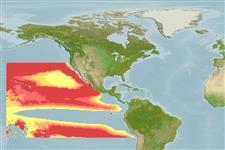>
Stomiiformes (Lightfishes and dragonfishes) >
Stomiidae (Barbeled dragonfishes) > Melanostomiinae
Etymology: Eustomias: Greek, eu = good + Greek, stoma = mouth (Ref. 45335).
More on author: Beebe.
Environment: milieu / climate zone / depth range / distribution range
Ecología
marino batipelágico; rango de profundidad ? - 1828 m (Ref. 125180). Deep-water; 40°N - 20°S
Atlantic, Indian and Pacific: 40-20°N and 80-30°W in the North Atlantic; near 20°S and 30°W in the South Atlantic; near Hawaii and scattered locations in the western and southern Pacific; two stations in the southern Indian Ocean.
Length at first maturity / Tamaño / Peso / Age
Maturity: Lm 12.6, range 12 - 13.3 cm
Max length : 14.9 cm SL macho / no sexado; (Ref. 36852); 17.7 cm SL (female)
Short description
Morfología | Morfometría
Barbel with three branches arising from stem; medial branch shorter than lateral branches but all similar in structure; external pigment present on barbel stem and dorsal surface of terminal bulb except for unpigmented tip; distal boundary of pigment irregular and forked dorsally; terminal bulb with a single or a single-based group of three to six terminal filaments near distal tip.
Life cycle and mating behavior
Madurez | Reproducción | Puesta | Huevos | Fecundidad | Larva
Paxton, J.R., D.F. Hoese, G.R. Allen and J.E. Hanley, 1989. Pisces. Petromyzontidae to Carangidae. Zoological Catalogue of Australia, Vol. 7. Australian Government Publishing Service, Canberra, 665 p. (Ref. 7300)
IUCN Red List Status (Ref. 130435)
Threat to humans
Harmless
Human uses
Pesquerías: sin interés
Más información
Age/SizeCrecimientoLength-weightLength-lengthLength-frequenciesMorfometríaMorfologíaLarvaDinámica larvariaReclutamientoAbundanciaBRUVS
ReferenciasAcuiculturaPerfil de acuiculturaRazasGenéticaElectrophoresesheritabilidadEnfermedadesProcesamientoNutrientsMass conversion
ColaboradoresImágenesStamps, Coins Misc.SonidosCiguateraVelocidadTipo de nataciónSuperficie branquialOtolitosCerebrosVisión
Herramientas
Special reports
Download XML
Fuentes de Internet
Estimates based on models
Preferred temperature (Ref.
123201): 2 - 2.2, mean 2.1 °C (based on 26 cells).
Phylogenetic diversity index (Ref.
82804): PD
50 = 0.5000 [Uniqueness, from 0.5 = low to 2.0 = high].
Bayesian length-weight: a=0.00302 (0.00117 - 0.00783), b=3.12 (2.89 - 3.35), in cm total length, based on LWR estimates for this (Sub)family-body shape (Ref.
93245).
Nivel trófico (Ref.
69278): 4.3 ±0.8 se; based on size and trophs of closest relatives
Resiliencia (Ref.
120179): Alto, población duplicada en un tiempo mínimo inferior a 15 meses (Preliminary K or Fecundity.).
Fishing Vulnerability (Ref.
59153): Low vulnerability (12 of 100).
